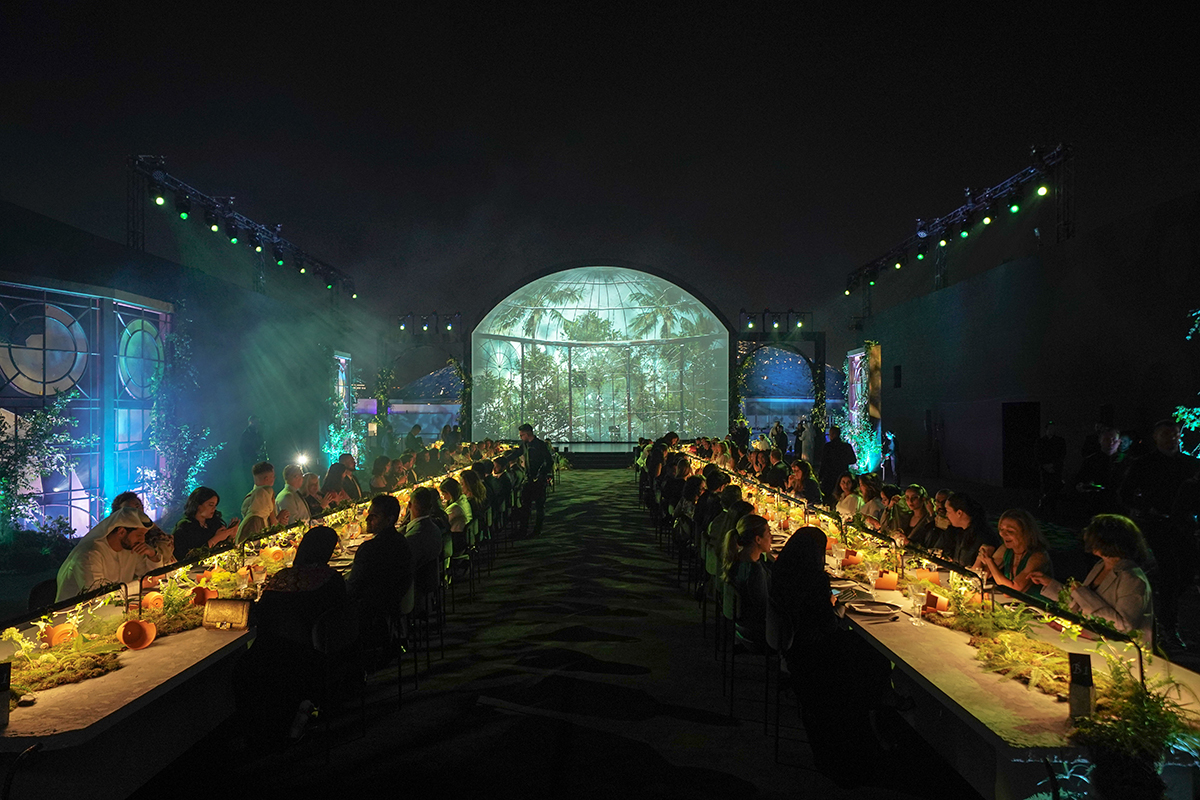
Dinner at the ceremony for the Richard Mille Art Prize, against the spectacular backdrop of
Louvre Abu Dhabi
One of the art world’s most prestigious awards, the Richard Mille Art Prize in partnership with Louvre Abu Dhabi, was this year awarded to a female artist in the Gulf. Darius Sanai visited Louvre Abu Dhabi for the big event
Under a starlit sky by the edge of the Gulf, two celebrated dancers are performing classical ballet to Beethoven‘s Moonlight Sonata. Two long tables of guests-art collectors, government officials, artists and watch collectors- look on, mesmerised.
The performance is choreographed and led by Benjamin Millepied, the renowned director, dancer, and choreographer (including of the film, Black Swan), and husband of film star Natalie Portman. His accompanying danseuse is Caroline Osmont, of the Paris Opera Ballet. The dance is short, but beautiful. When I ask Millepied afterwards how it is to create and then perform a routine to the Moonlight, which was not written to be danced to, he simply smiles, and says, “I liked it!”
Follow LUX on Instagram: luxthemagazine
Memorable as it was, the dance at the gala outdoor dinner was just a warm-up for the main act: the announcement of the winner of one of the most significant art prize in the world-and quite possibly the most financially rewarding: the Richard Mille, art prize in partnership with Louvre Abu Dhabi. Worth $60,000 to the winning artist, the Prize, awarded by the uber-luxury, high-tech watch brand, also sees it ten shortlisted regional candidates display that works at Louvre Abu Dhabi, the local iteration of the fabled, Paris museum, whose collection sweeps from ancient Persia to Cy Twombly.
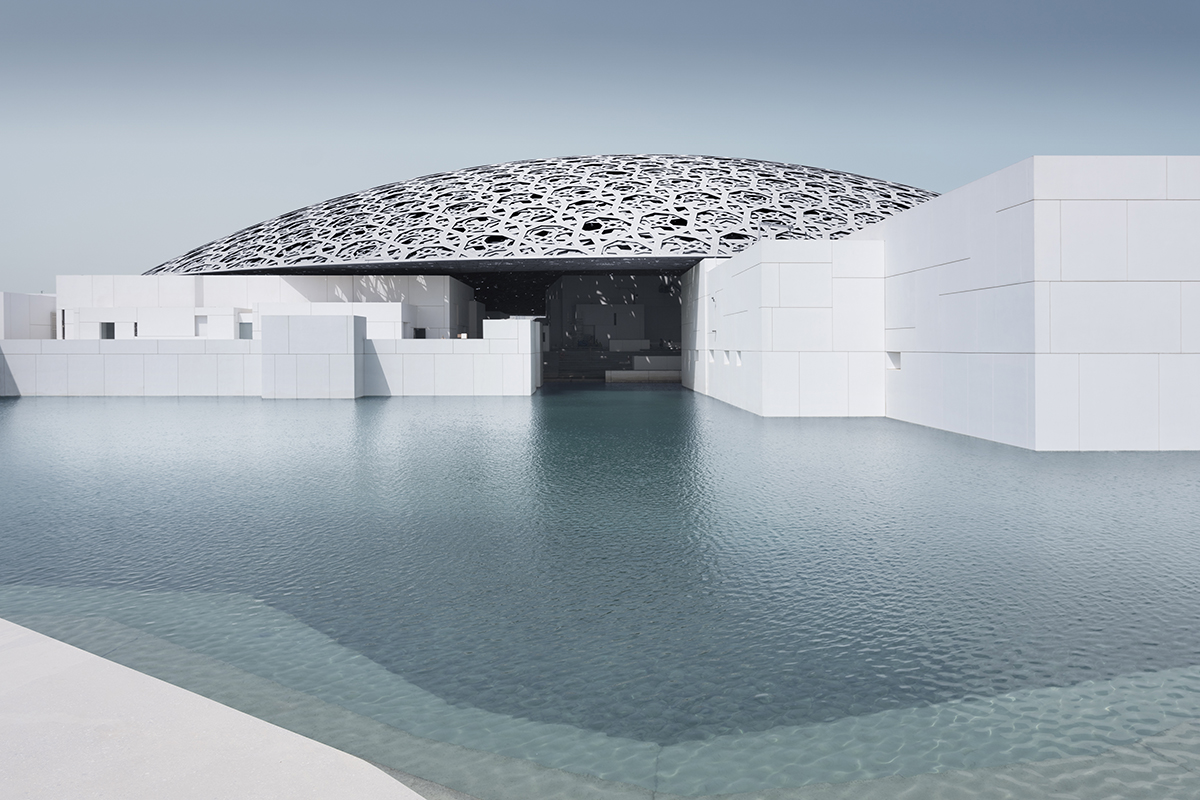
Louvre Abu Dhabi, designed by Jean Nouvel
Louvre Abu Dhabi is the cornerstone of an impressive, new cultural district in the Emirate, which will soon house further significant museums, including a Guggenheim, and which is already home to the astonishing Abrahamic Family House, an interfaith complex, comprising a mosque, cathedral and synagogue (plus an education centre), devoted to the three major Abrahamic faiths and nurturing mutual understanding.
Earlier that day, we’d had a private tour of the new Louvre (which was closed to the public, as it is every Monday). The “Art Here, 2022” exhibition, housing, the shortlisted works, had pride of place in the museums Forum. The theme in this, the Prize’s second year, was “Icon. Iconic.“, a suitably art-world-gnomic concept allowing artists to exercise their full creative imaginations. Eight of the ten artists on the shortlist were female, and encouraging affirmation for women in these times.
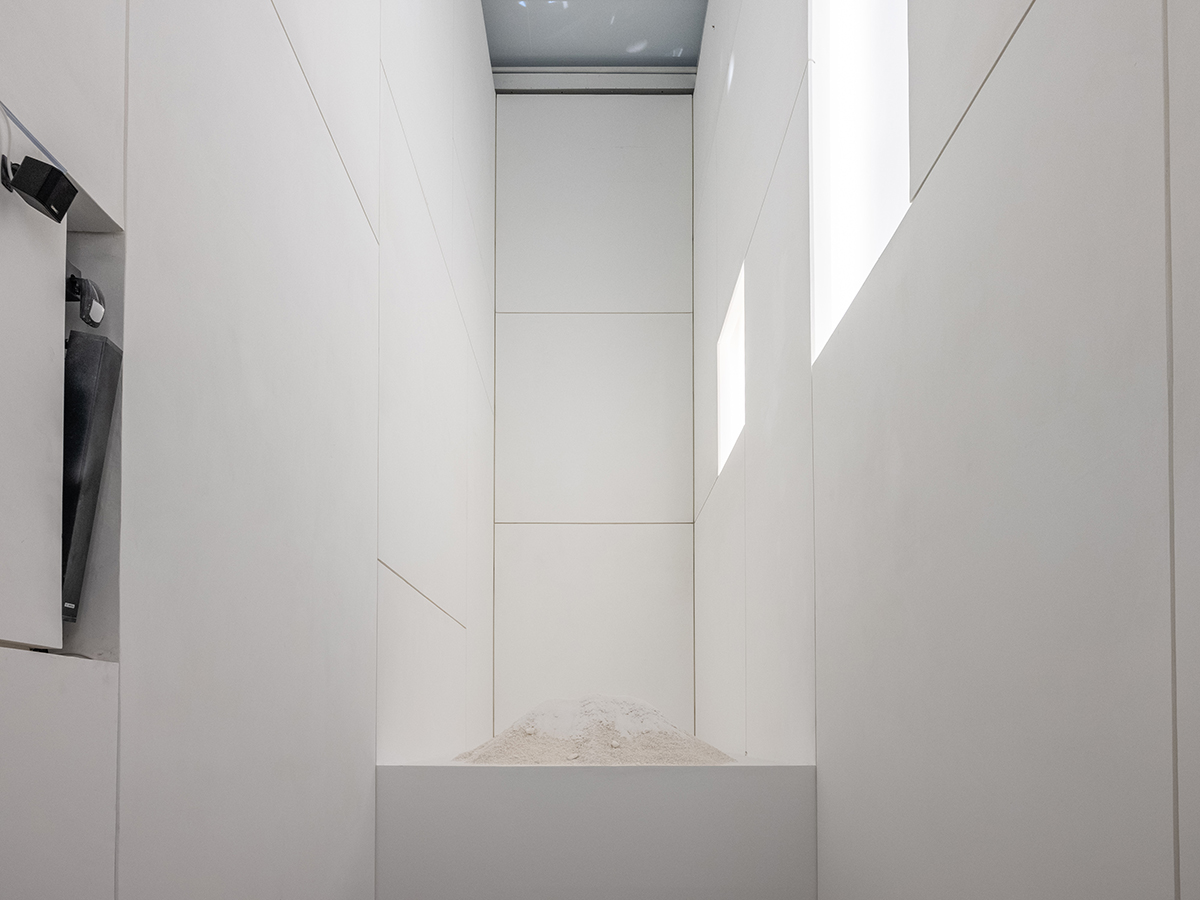
Between Desert Seas, 2021, by Ayman Zedani
The first work is so complex it required several minutes to negotiate and understand. Ayman Zedani’s Between Desert Seas approaches you visually as white salt on an internal roof; and then aurally, as a soundtrack that you quickly realise, is about the plight of the Arabian Sea humpback whale. Listening for a couple of minutes, between whalesong, you learn that these non-migratory whales are a unique species, derived from a pod that became separated from the rest of whalekind around 70,000 years ago. They have developed the own song and culture – and they are under existential threat. Global warming has acidified and poison to the sea, and the removal of water for desalination has made it more toxic.
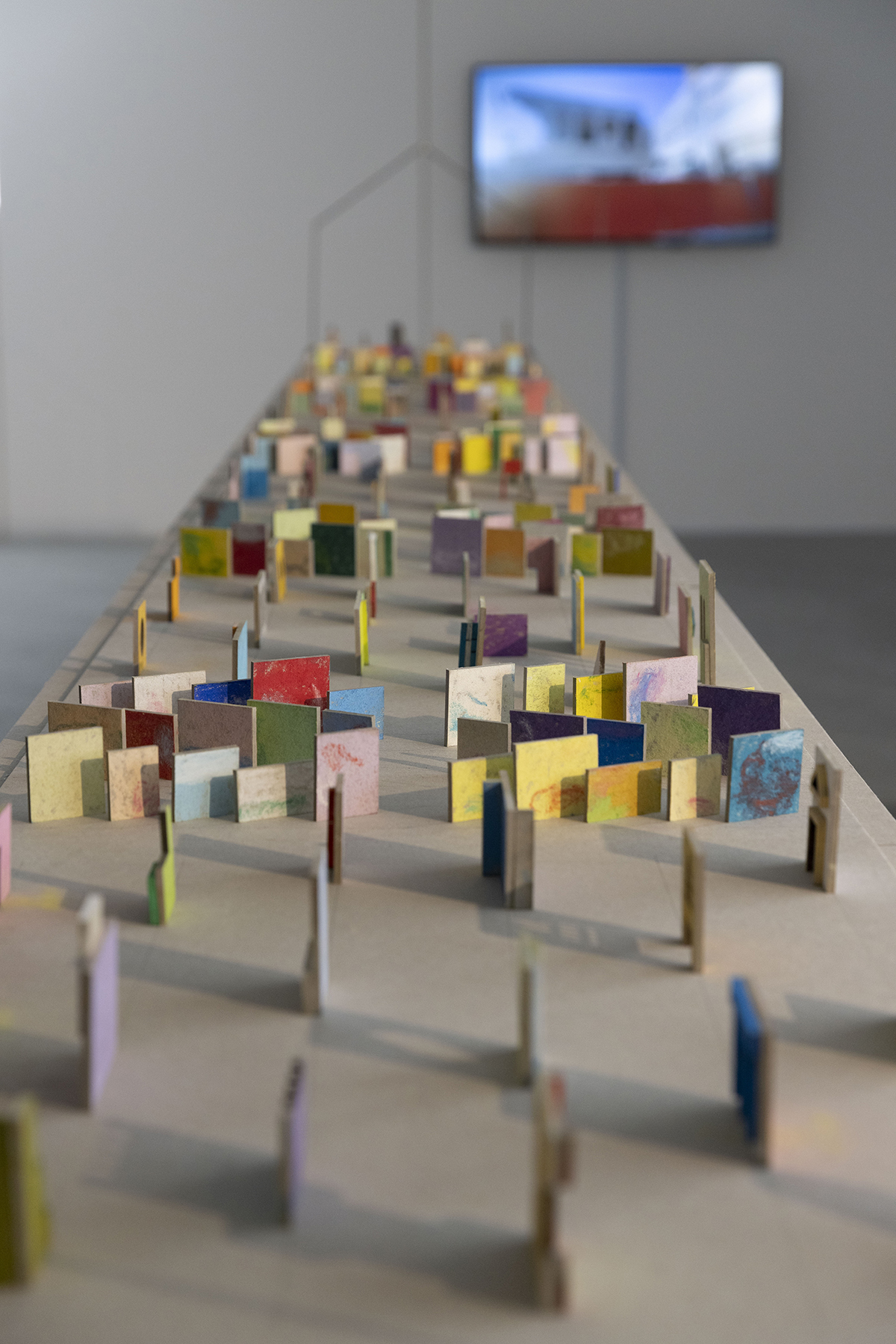
Wall House, 2022, by Vikram Divecha
Wall House, by Vikram Divecha, is a proposal by the artist to remove and retain the walls of hundreds of houses in the region that are slated for demolition, and preserve them to show a portrait of our times has created by the houses’ inhabitants. The idea is illustrated by a 1:100-scale maquette, showing what is a large scale installation of this project could look like.
There was Sidelines, a work by Saudi artist Manal AlDowayan, celebrating the intricate heritage of weaving in Saudi history, lost when oil money started flowing in the 20th century.
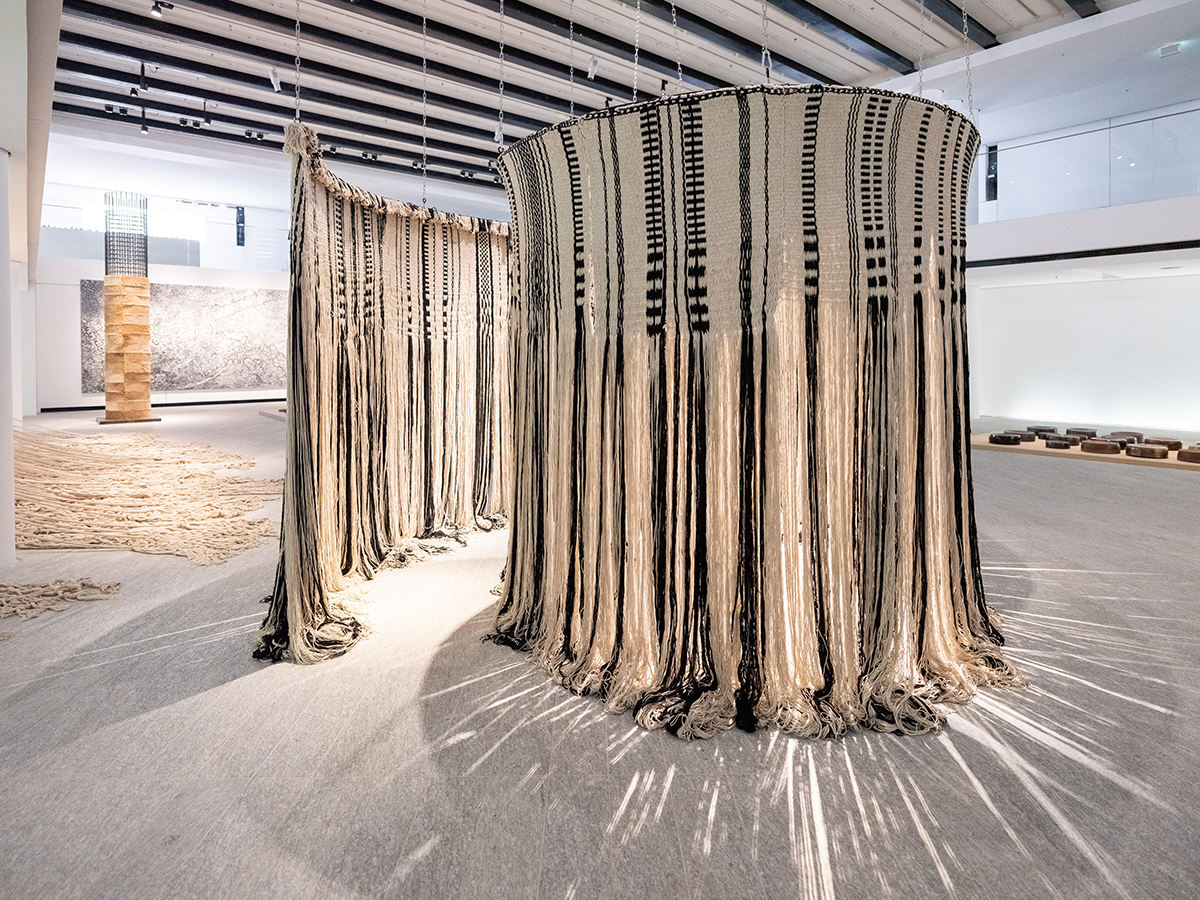
Sidelines, 2016, by Manal AlDowayan
Afra Al Dhaheri, an artist from Abu Dhabi, showed Weighing The Line, a striking workers, consisting of hanging ropes, pulled down by ropes on the ground-symbolising, in the artists’ words, social conditioning and constructs.
I was particularly struck by Xylophone, a work on pyro-engraved scrap wood by Elizabeth Dorazio, a Brazilian artist, now resident in Dubai. The artist said she wanted to make a statement that wood is a “vestige of excess extractavism”- and the work is quite beautiful and engaging.
UAE-born artist and academic Shaukha Al Mazrou created A Still Life of an Ever-Changing Crop Field, in glazing ceramic, inspired by crop circles, and “natures place in the world, invaded by human imprint”, one of the several environmentally inspired, works and beautiful as an installation.
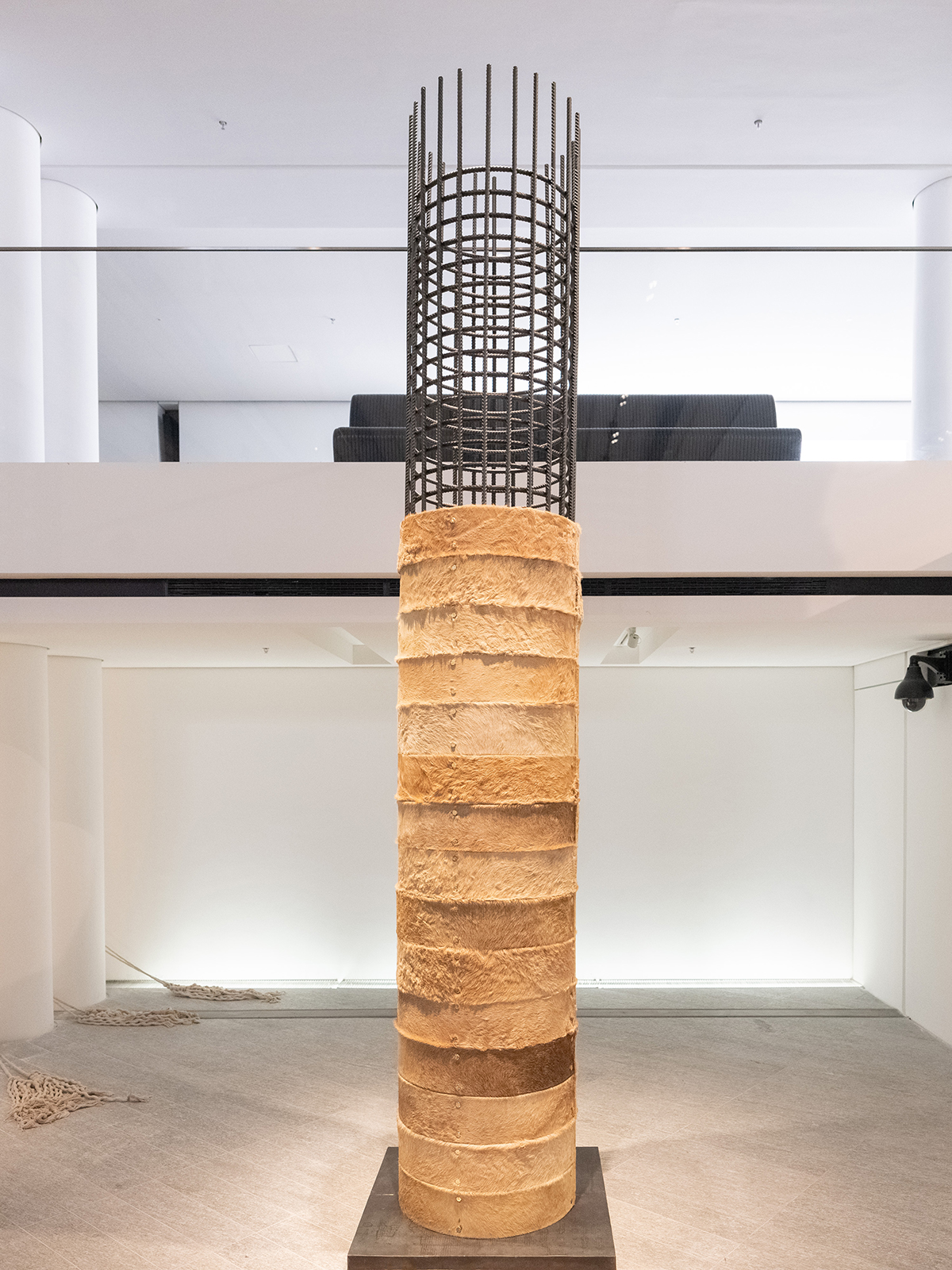
Camouflage: The Fourth Pillar, 2022, by Zeinab Alhashemi
Perhaps the most visually arresting work, Break of the Atom and Vegetal Life (after Zeid), is by Abu Dhabi-based artist, Simrin Mehra-Agarwal. It is a complex work that appears on first sight to be a tapestry. It is, in fact, made of graphite, charcoal, ink, primer, plaster, gypsum powder, stucco, acrylic, gesso, glue, sand, fibreglass, vellum, Mylar and paper on wooden panels. The artist says it “questions nature and its various states of bloom and decay within the context of the histories of war or neglect, as well as the contemporary issue of climate change”. Powerful, complex, at first sight, it looked like a maelstrom of clouds viewed from a satellite.
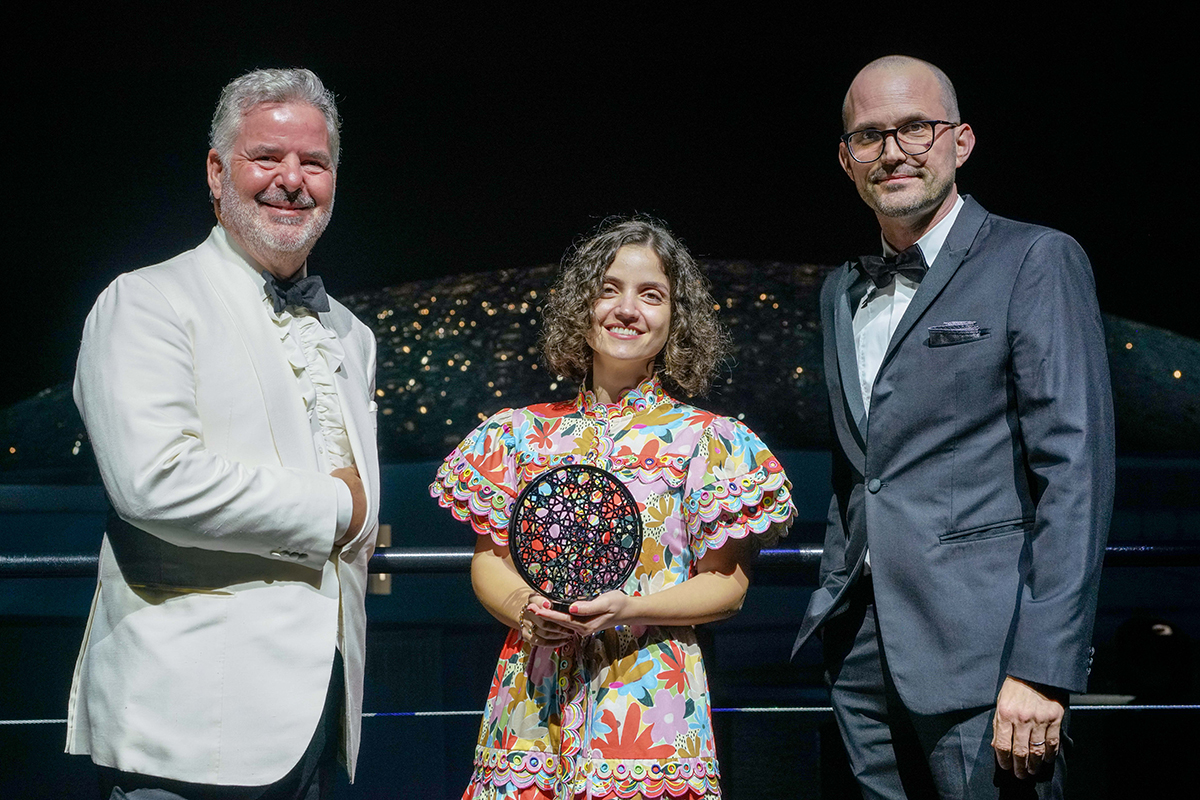
Peter Harrison, CEO of Richard Mille EMEA,
and Manuel Rabaté, Director of Louvre
Abu Dhabi, present the 2022 Richard Mille Art Prize in partnership with Louvre Abu Dhabi to Rand Abdul Jabbar
Zeinab Alhashemi, an artist, based in Dubai, submitted the fourth pillar, from her camouflage series that featured at the celebrated DesertX AlUla. The pillar mimics the pillars at the gallery and, made of camel hides over metal rods, tones with the surrounding desert.
Standing by the ruins, the work of mosaic clay tiles by Dana Awartani, an artist based in Jeddah with Saudi and Palestinian roots, was visually striking on the lower floor. Awartani says she deliberately did not use the straw traditionally utilise in the region is tiles, thus allowing them to crack naturally overtime.
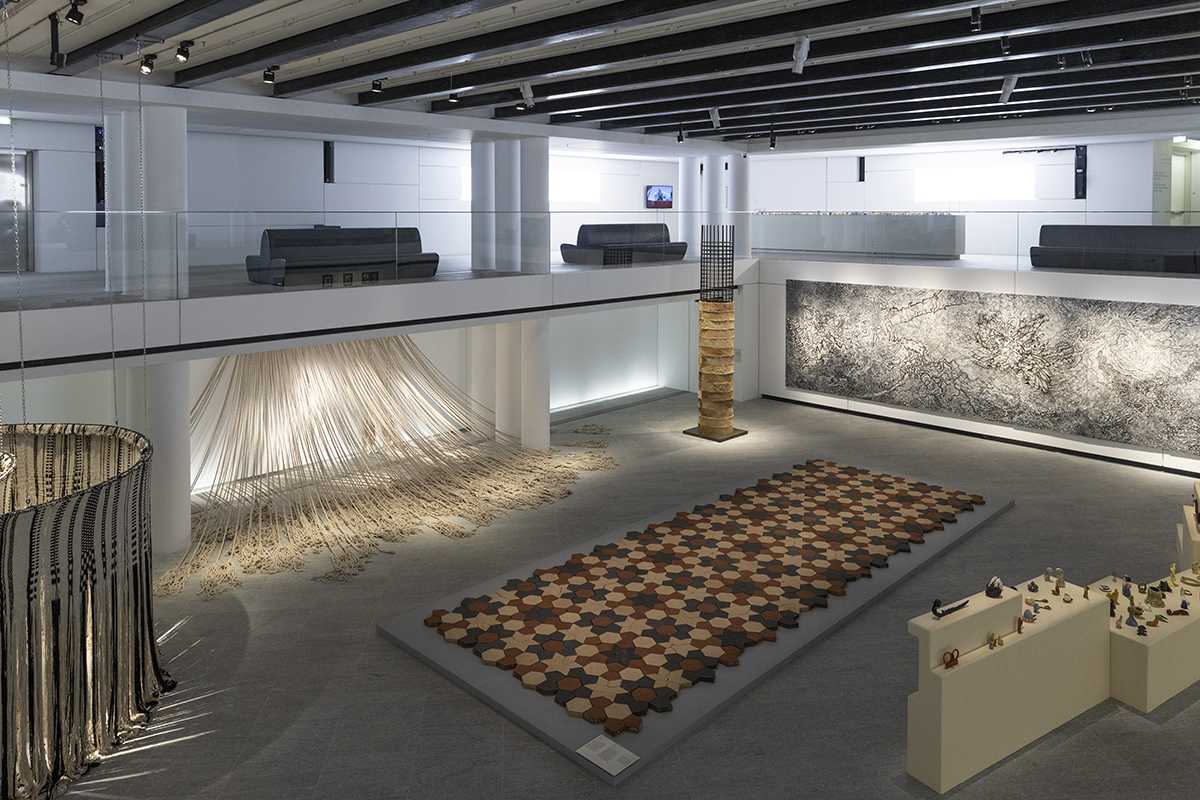
Installation view of Standing By the Ruins, 2022, by Dana Awartani
Next to this work was a long plinth on which was displayed 100 of exquisite, intricate little glazed stoneware figures. In a panoply of colours and sizes, earthly wonders, celestial beings, featured, plays, on jugs, cups, human, and natural figures, that related directly as a modern take on Mesopotamian stoneware, including some in the new recollection. The artist, Iraqi-born Rand Abdul Jabbar, is based in Abu Dhabi.
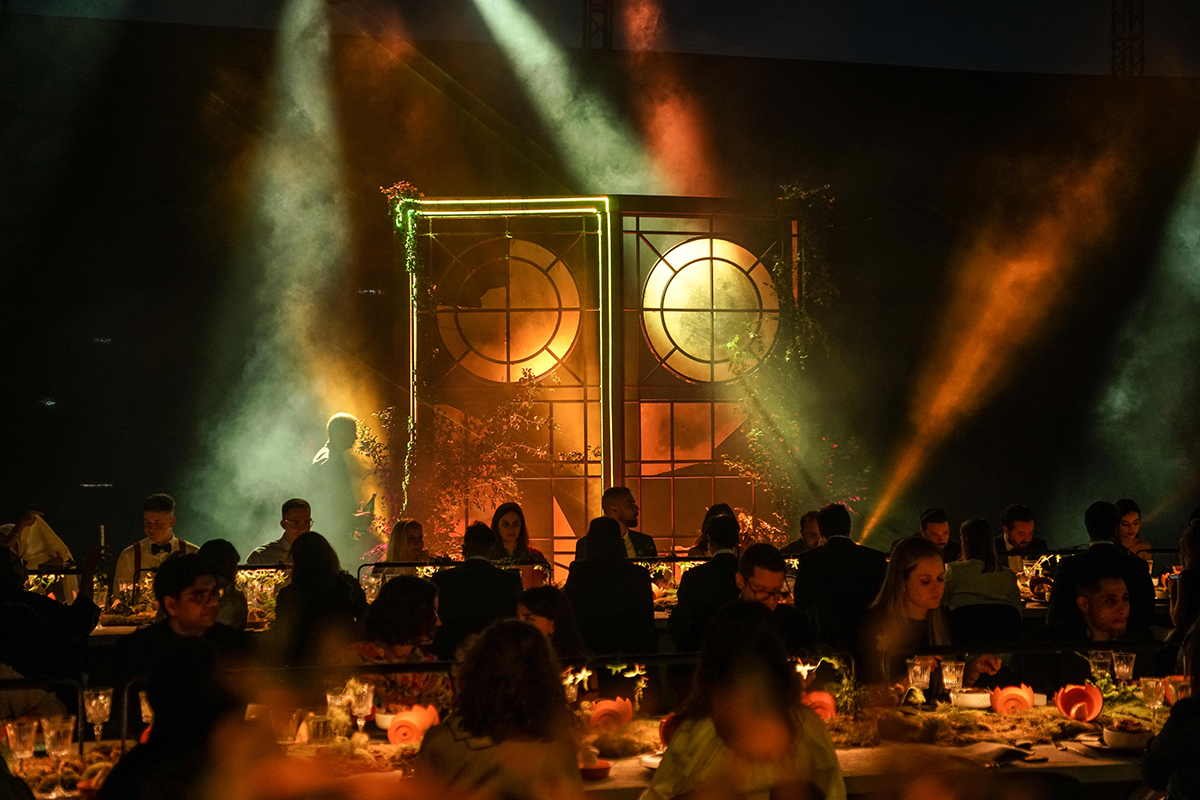
Dinner in stunning surroundings
One of the most valuable art prizes in the world (if not the most back valuable); eight out of ten artist, shortlisted female; powerful themes of environmental loss; significant pedigree from all the artists and support and an exhibition at a Louvre. Why isn’t the Richard Mille Prize even better known, I pondered, while on my way to the prize giving event that evening?
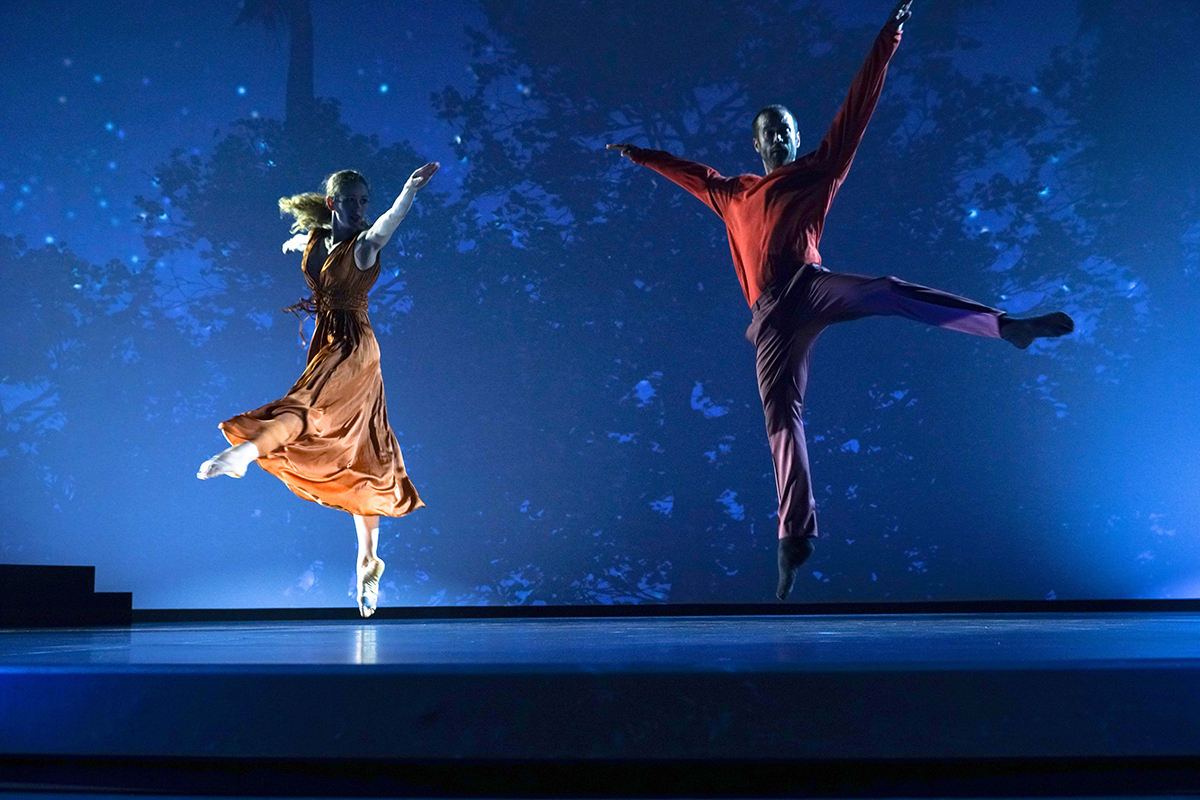
The ceremony, Benjamin Millepied and Caroline Osmont perform a
ballet choreographed by Millepied to Beethoven’s Moonlight Sonata
Perhaps because the Middle East and Gulf region is relatively new to the contemporary art scene (they’re not the ancient art scene, in which it predates the West by millennia); or perhaps, because the Western eye does not yet quite respect this part of the East and its culture as it should. In any case, credit to the powerful French brand, the Louvre and iconic Swiss brand Richard Mille for making it happen.
The evening after the dance and a performance by Dutch singer, Davina Michelle, the winner was announced: Rand Abdul Jabbar is Earthly Wonders, Celestial Beings. The artist was presented with the award and generous check.
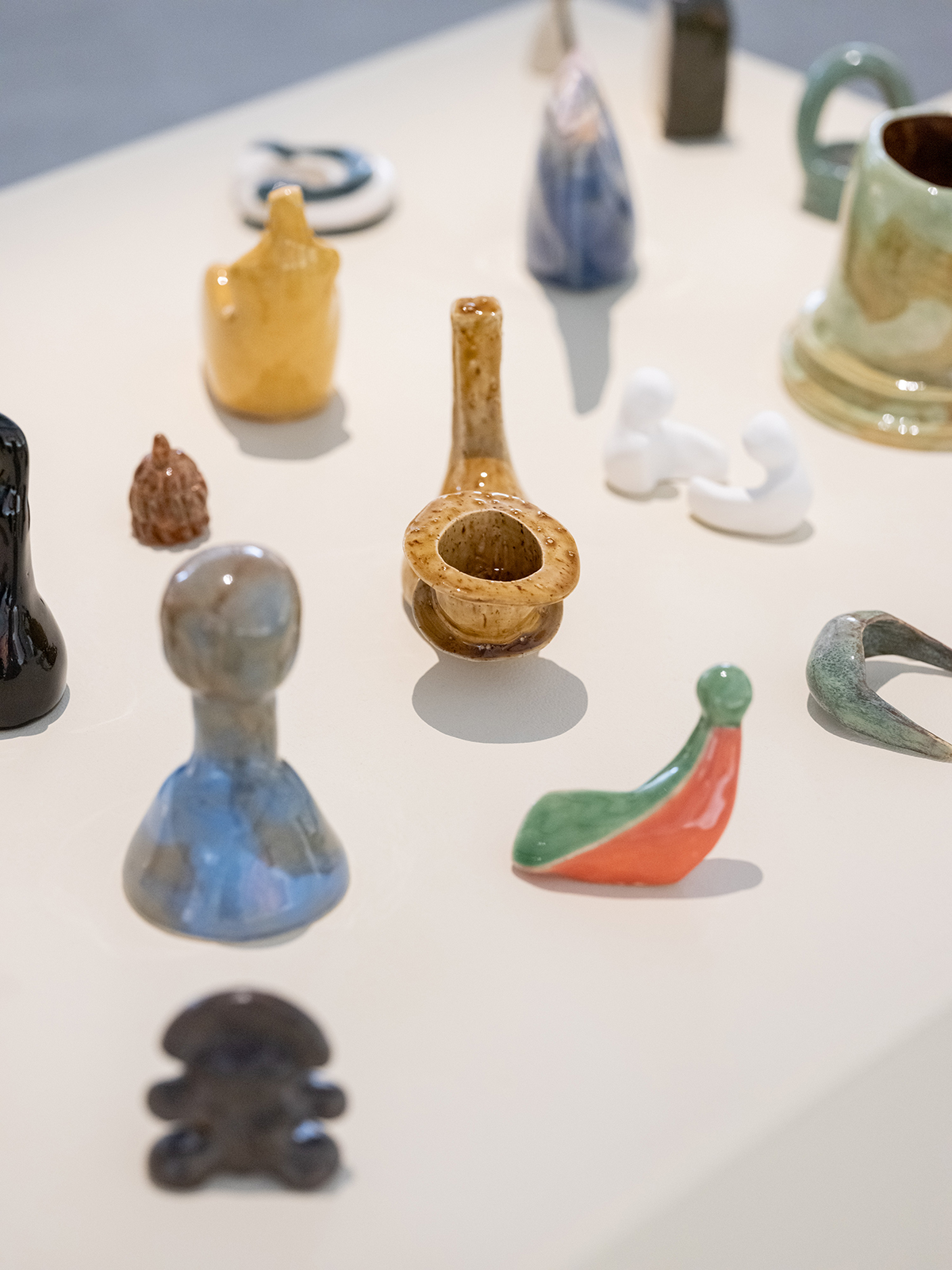
Earthly Wonders, Celestial Beings, 2019-ongoing, by Rand Abdul Jabbar
“Rand Abdul Jabbar delivered outstanding works at push the boundaries of contemporary creativity,” said Peter Harrison, CEO of Richard Mille EMEA. “This is a celebration of our tenure partnership with Louvre, Abu Dhabi, and 10 incredible artist from the region, whose work was inspired by their cultural roots.”
Read more: Deutsche Bank: The Art Collection You Didn’t Know About
The originality, power and scope of a generation of artist, based in the Gulf that had been made clear. This is a region that is artistically, on fire.
Find out more: richardmille.com/louvre-abu-dhabi
This article was first published in the Spring/Summer 2023 issue of LUX








